Switzerland prepares to celebrate its birthday
August 1 is highly felt and participated in by Swiss citizens, celebrated throughout the Confederation with political speeches, bonfires, fireworks, barbecues etc.
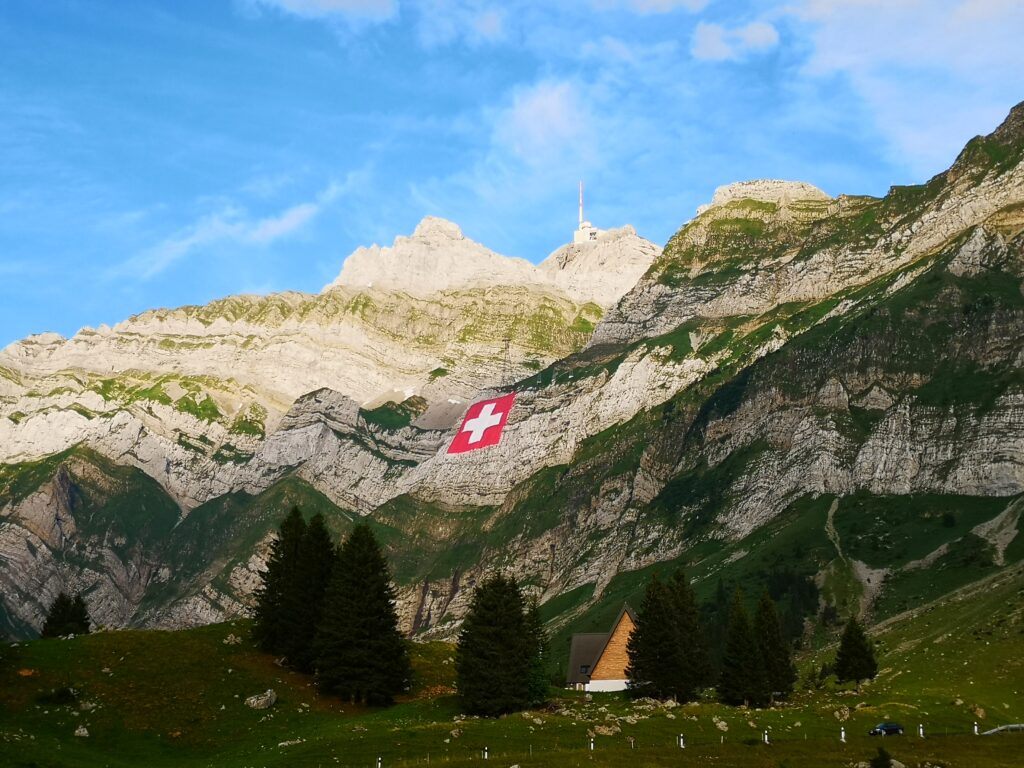
On August 1, Switzerland commemorates the 1291 Federal Pact in which the cantons of Uri, Schwyz and Unterwalden solemnly pledged mutual assistance in the event of an external threat. Legend has it that representatives of the three founding cantons known as “the Three Confederates” swore on the meadows of the Rütli, (above Lake Lucerne), to free the country from the Habsburgs.
The official National Day is held on August 1 at this place with an address to the whole nation by the president or president of the Confederation.
With the 1993 referendum, August 1 officially became a vacation throughout Switzerland.
The confederation is one of the oldest existing states in the world.
On Aug. 1 throughout the Swiss Confederation, bonfires are lit, fireworks are shot off, and in some municipalities children parade through the streets with lanterns decorated with the Swiss cross and their canton’s coat of arms, and there are processions with traditional costumes, yodeling choirs, alphorn players and flag-waving. Across the country, politicians from federal councilors to mayors give speeches.
At 8 p.m. also, all the bells in Switzerland ring festively.
Federal pact
Concluded in early August 1291, it is considered the oldest Swiss constitutional act. With it, the valley communities of Uri, Schwyz and Nidwalden pledged to help each other against all those who did them violence or wrong, to refuse the presence of foreign judges but also to keep existing power relations unchanged.
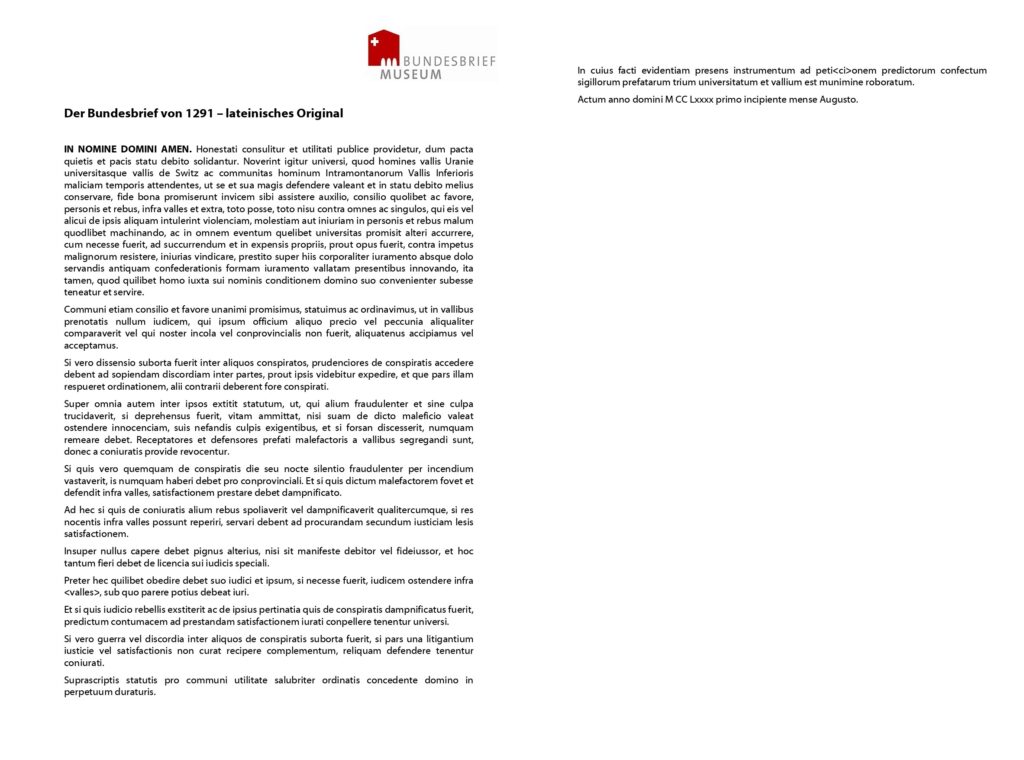
Latin Text Summary
The following peace arrangements are agreed upon for the common good :
- In view of the difficult times, the people and communities of Uri, Schwyz and Unterwalden pledge to lend each other mutual aid by all means against all those who, in the valleys or outside them, would do them wrong or violence.
- Each community rushes to the aid of and gives advice to the other, at its own expense, to repel aggression against persons or property in the valleys and outside them, and takes an oath confirming and renewing the ancient pact.
- Each is bound, according to his personal condition, to render obedience to his lord.
- The function of judge in the aforementioned valleys cannot be purchased and can be exercised only by members of the community.
- Conflicts between confederates must be settled by the most circumspect, whose decision will be defended by all.
- Assassination is punishable by death. If the perpetrator has fled, he shall be forbidden to return. One who protects a murderer is likewise banished from the valleys until the confederates authorize his return.
- Arsonists lose their status as confederates, and those who aid or defend them must themselves compensate the injured party.
- Anyone who robs a confederate or otherwise causes him harm shall be liable with his property in the valleys.
- The property of debtors or guarantors may be attached only with the permission of the judge.
- Everyone must obey his judge and, if necessary, indicate which judge in the valley is under whose jurisdiction he is.
- Whoever refuses to submit to the judgment thereby causing prejudice to another confederate shall be compelled by all to make corresponding reparation.
- Cases of war or litigation between confederates shall be settled by arbitration; if one party does not wish to submit to the court or pay compensation, the confederates shall take up the defense of the other party.
- These arrangements for the common good are of perpetual duration.
Provided with the seals of the three aforementioned communities and valleys, this covenant was concluded at the beginning of August in the year 1291.
National Anthem
The national anthem is the “Swiss Psalm” written in 1841 by Leonhard Widmer, while the melody is by Alberich Zwyssig.
The text is composed in the four nationalities.
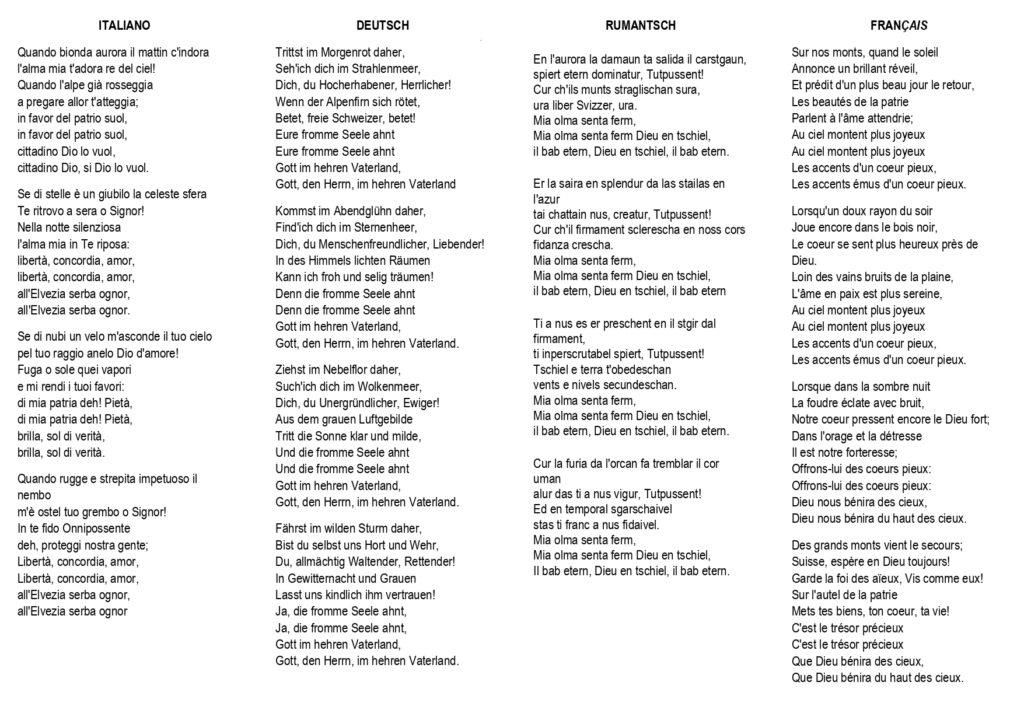
August 1, 2022: speeches by members of the Federal Council
The presence of members of the Federal Council and the Federal Chancellor on the National Day and their speeches.
| Members of the Federal Council | Date and place |
| Ignazio Cassis,
President of the Confederation |
01.08 Morning Farm Brunch in Knonau (ZH).
01.08 Afternoon, Grenchen (SO) 01.08 Starting at 17h, Plateforme 10, Lausanne (VD) 01.08 Evening, Lausanne, Ouchy (Fireworks) (VD) |
| Alain Berset | 31.08 Lucerne (LU)
01.08 Stein am Rhein (SH) 01.08 Bellerive (VD) |
| Ueli Maurer | 01.08 Dietlikon (ZH)
01.08 Neunkirch (SH) 01.08 Marbachegg (LU) |
| Simonetta Sommaruga | 31.07 Saas-Balen (VS)
01.08 Fribourg (FR) |
| Guy Parmelin | 01.08 Brunch on the farm Hofbeiz Bürli-Schiirli, Oberwald (VS)
01.08 Sessa (Tresa Municipality) (TI) |
| Karin Keller-Sutter | 01.08 Moléson (FR) |
| Viola Amherd | 01.08 Winterthur (ZH) |
| Walter Thurnherr, Federal Chancellor | 31.07 Blatten (Lötsche) |

The Presidency of the Helvetic Confederation from 1848 to the present day
Major events
The festival on the Rütli at Lake Lucerne (Canton Uri), the legendary scene of the oath.
At the Rhine Falls in the canton of Schaffhausen, a fireworks display can be witnessed that attracts many spectators.
On the Säntis (2502 meters) an 80-by-80-meter flag, (about the size of a soccer field) considered the largest Swiss flag in the world, is installed every year.
In Basel, public holidays begin each year on July 31 with the Federal Rhine Festival, where more than 90 pubs and stalls and live concerts provide visitors with entertainment from 5 p.m. and fireworks are exploded at 11 p.m.
Several events scheduled in the Confederation can be found here.
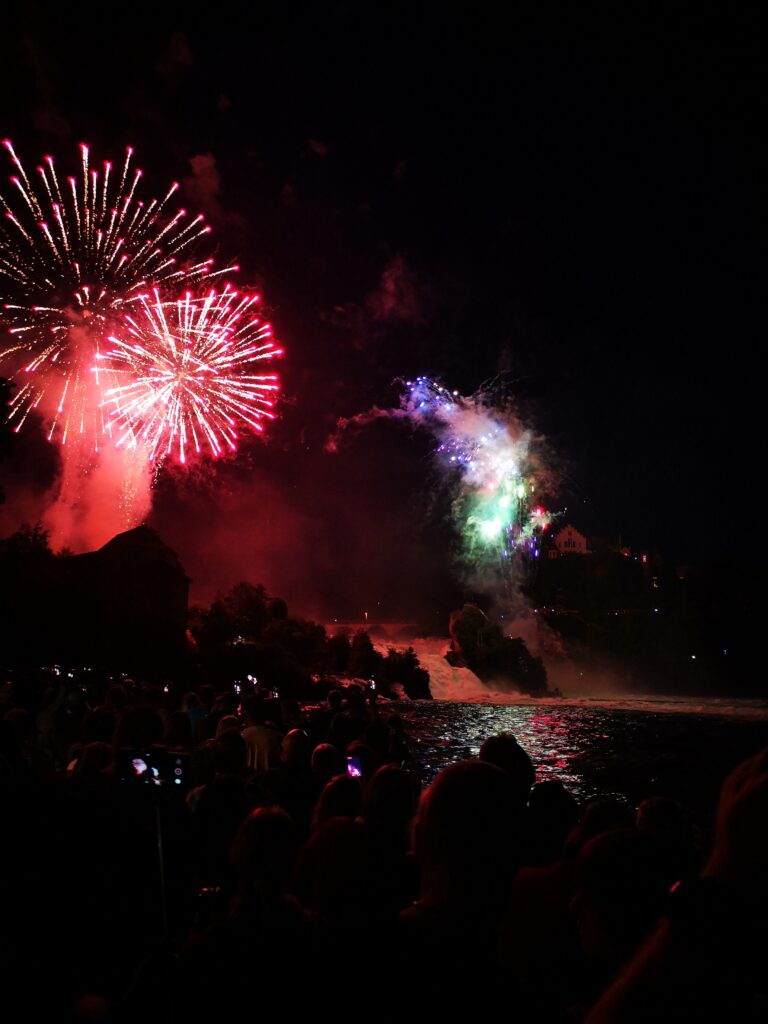
William Tell
The inhabitants of the valleys of Uri, Schwyz and Unterwalden (now Obwalden and Nidwalden) were the property of King Albrecht, and the imperial bailiffs Landenberg and Gessler sent by him tyrannized the people.
Gessler had a pole erected on the village square of Altdorf with a hat pinned on top of which everyone had to bow in submission. Wilhelm Tell, a conservative compatriot of Bürglen, refused to do so, and Gessler then ordered him to hit an apple on his son Walter’s head with an arrow from his crossbow: the test was passed.
Gessler, noticing a second arrow in Tell’s quiver asked him what it meant, and Tell replied that he would use it to pierce him if he hit his son. Tell was then made to be tied up and taken to a boat, which, however, was caught in a storm in the middle of the lake so Tell was untied so that he could help the rowers bring the boat safely close to the shore. Here Tell jumped out of the boat, onto a rocky plateau where Tell’s chapel in Sisikon stands today, and escaped to Küssnacht, where he waited for his enemy Gessler in the Hohlen Gasse and shot him with an arrow from his crossbow.
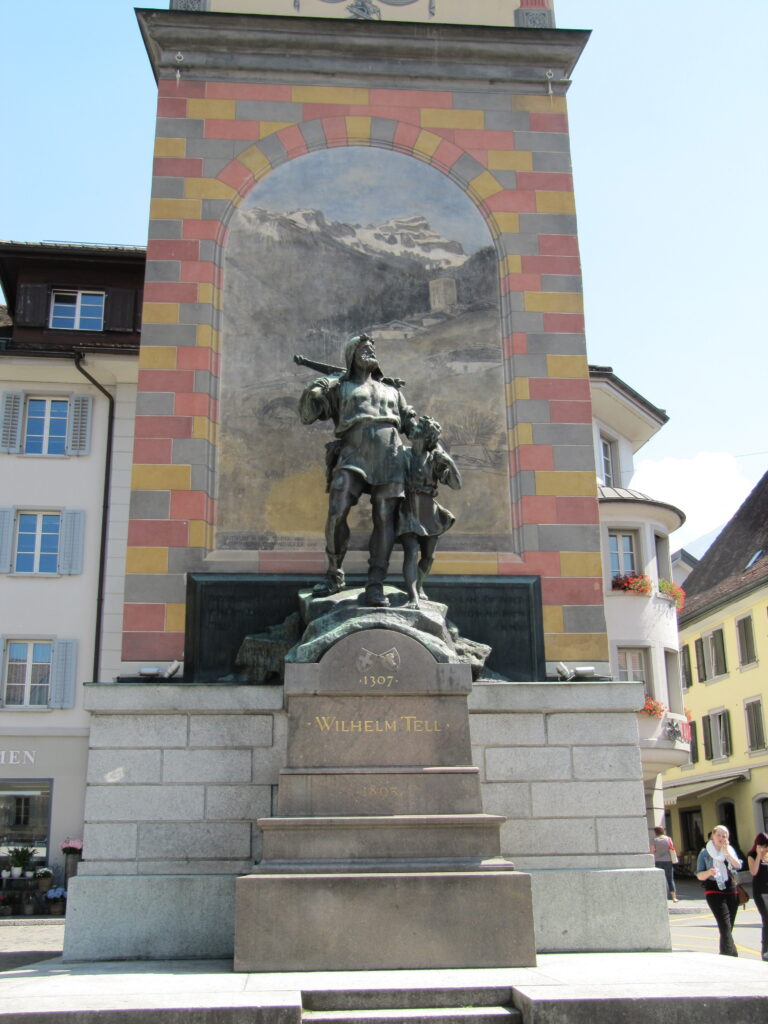
Tell’s deeds quickly became known throughout the country and strengthened the movement for freedom and independence in the original part of Switzerland.
Tell is a legendary figure who is said to have lived as a freedom fighter and tyrant in the 13th and 14th centuries although his true existence is certainly not proven.
A man named “Thall” is first mentioned around 1470 in the “White Book of Sarnen,” a copy-book of an Obwaldner Landamman, and at virtually the same time, but independently of it, in a war song from the time of the Burgundian Wars. The fearless and courageous mountaineer achieved worldwide fame as the protagonist of Friedrich Schiller’s 1804 drama “William Tell.”
In Switzerland, William Tell has been considered a national hero since the 16th century. He played a decisive role in shaping the self-image of the Swiss through his simplicity and modesty, but also his energy and desire for freedom. In the 19th century, Tell was very important as a myth and as the “Father of the Fatherland” in consolidating the newly created Swiss federal state in 1848. In Altdorf (UR), there is a monument dedicated to him created by sculptor Richard Kissling.
Saint Nicholas of Flüe
Nicholas was born in 1417 into a farming family in Flüe, in the Obwalden region of the then eight-canton Confederation of Central Switzerland.
Appointed mayor of Sachseln, cantonal councillor and judge, and deputy to the Federal Diet, he took part in several military campaigns between 1433 and 1460, working everywhere for humane treatment of the vanquished enemy, to spare churches and convents, and to protect women and children. As the divine call grew stronger in him, with the consent of his wife, by whom he had 10 children he chose as his home the Ranft, a lonely ravine where in 1468 his countrymen built him a hermit cell with a chapel: from there Nicholas would leave only to go to church in Sachseln, in 1473 in the face of the Austrian threat, and in 1481 and 1482 when there was grave danger of civil war: the good results of these interventions to preserve the peace had an effect that lasted for centuries and earned Nicholas, better known as Bruder Klaus the title “Father of the Fatherland.“
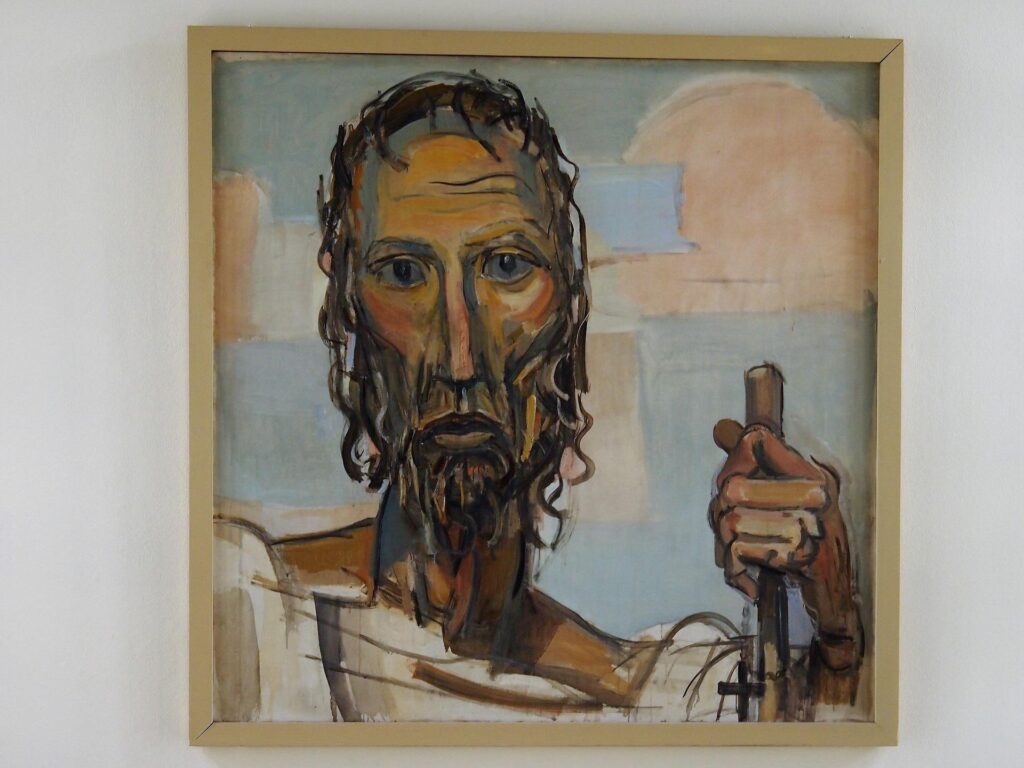
Clamorously, for the 20 years he spent in the hermitage at Ranft, he lived by feeding only on Communion-a miraculous fast, examined by the Church and civil authorities, which is historically proven with absolute certainty.
He died in his Ranft hermitage on March 21, 1487. In 1669, Clement IX allowed the public veneration of Nicholas for the canton of Obwalden, later extended by Clement X to all of Switzerland, and on May 15, 1947, Pius XII canonized Nicholas of Flüe, declaring him Switzerland’s principal patron saint.





